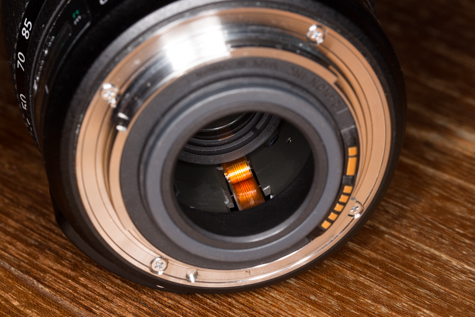A lot of people are looking into creative ways to use their regular lenses for macro. The trick is to make a lens focus up closer so magnification is boosted. Tubes are a good idea, close-up lenses might work. Reversing your lens is a whole other ballgame, and it can lead to significant magnifications. But is it all as cool and easy as it sounds?
Most often seen: Reversing a 50mm lens
For some reason a lot of people take a 50mm and try to reserve it. When you play with it, not really surprising though: 50mm lenses are simple (aka cheap), and their focal length seems to be somewhat of a sweet spot when reversing. So I took my trusty plastic fantastic (Canon EF 50mm f/1.8 II) and got some extra goodies:
The reverse ring came from ebay, and is certainly “good enough” metal quality. You simply screw this adapter on the filter threads of the 50mm lens, and the other side of the reverse ring clicks on the camera.
I also added a “Rear Lens Mount Protection Ring” from ebay. This ring goes on the back of a lens (which is now the front 🙂 ) and you can mount an 58mm protective filter on there.
You may ask: Why is it so important to have a protective ring on the rear of the lens? Things become especially clear when you look at the rear of an EF-S lens. Imagine shooting flowers in a field with a reversed EF-S lens looking like this:

Detail of the rear of an EF-S 15-85mm lens. All unprotected, not a good idea to take this setup out shooting.
Chances are your EF-S lens will catch some dirt or pollen right into the inside of the lens. Not something you’d want!
Mounting a ring flash on a reversed lens
Whenever I shoot macro, I want (or rather need) to have a flash added. You could use a reporting-style flash or even the popup flash, but as you progress in macro shooting you’ll soon discover you want a ring flash.
Adding a ring flash to the setup is actually not even that hard once you have the Rear Lens Mount Protection Ring: You can simply mount the ring flash on the 58mm thread of the protection ring:
This actually works quite well, and it no reason not to use a lens reversed. The next thing however might be a big spoiler…
First mayor issue: Reversed lenses are wide open
Now we’re getting into some details that will seriously limit what you can do with a reverse-mounted lens: As the lens has no electronic connectivity, the lens will just sit there wide open. In my case at f/1.8 and… f/1.8 is next to useless for macro shooting: the Depth of Field (DoF) is just too small to be useful.
So I need some magic to close the aperture of a non-powered EF(-S) lens. Here comes a big magic trick how you can do this:
MAGIC TRICK FOR MANUALLY CLOSING CANON EF(-S) LENSES APERTURES
- Mount the lens as you normally would on your camera;
- Set the camera to M or Av mode, and set the aperture to what you need (for example f/10);
- Press the “DoF preview” button on your camera and keep it pressed;
- Unmount the lens while keeping the DoF preview button pressed.
And presto! Your lens is now closed to f/10 and stays there (until you mount it normally on your camera again and switch the camera on):
In case you wonder where the DoF preview button is… On my 7D it sits here:
There is one obvious downside to this: You’re now looking through an f/10 lens which is pretty dark. And for exactly that there is in fact a solution you can buy…
Meike electronic reverse ring: to the rescue?
Meike created a solution for the not-powered reversed lenses. They created a reverse ring that keeps the lens powered while shooting. It looks like this:

Meike Reverse Ring for Canon EF(-S) mount. This ring enables you to reverse lenses AND keep them powered by the camera.
When you mount this, the lens stays fully operative. That means the aperture is wide open, and even though the lens is mounted in reverse, the camera still sees the lens and is able to control the aperture just like a regularly mounted lens!
This appears to be the absolute optimum when shooting with reversed lenses, but is it really? To be useful, I need to build a setup which features these components:
- A camera (in my case an EOS 7D);
- The first element of the Meike electronic reverse kit;
- A ring mounted on the Meike to allow for a 58mm lens to be screwed on;
- A step-up ring from 58mm to 52mm for the Canon EF 50mm f/1.8 II (Meike has no 52mm option);
- The reversed Canon EF 50mm f/1.8 II lens;
- The second part of the Meike electronic reverse ring;
- A 40.5 to 58mm step-up ring to mount the protective filter and ring flash;
- The 58mm protective filter;
- An 58mm ring to mount the Nissin ringflash;
- The Nissing MF18 ring flash.
That will construct a setup like this:
THIS IS RIDICULOUS! How much stuff do I have to add to get this working?!?! The worst part is, that reversed lenses have a very small working distance to begin with. With all of this added stuff, I find the Meike reverse ring to be a structural problem. Not only do I have to build out this monster setup, but the Meike reverse ring adds tubing to the setup on both ends; tubing the lens to the camera makes the working distance even smaller, tubing on the front of the setup makes it almost impossible to shoot anything (or even get it properly lit).
In the end, I just started shooting without the Meike reverse ring but just used a cheap, thin metal reverse ring with a fixed f/10 aperture.
Shooting the reversed 50mm setup
Time to take the setup out for some shooting. First I did a such a truly creative shot of the 50mm’s lens cap:
To make a more interesting shot I stumbled upon a small nest of tiny tiny spiders (around 1mm each). This is an uncropped shot of them using the reversed 50mm setup:
A 1-1 crop of the same shot:
I took this shot in M mode. ISO 100, 1/160th and f/10 (fixed). The Nissin MF-18 on manual mode 1/32th.
Just for comparison, the same shot with my 7D + 100L + Nissin MF-18:
And a 1-1 crop of this shot:
Is the Canon 100mm f/2.8L a better macro lens? It better be! Is the 50mm reversed so much worse? Actually… It’s pretty good! So if you can live with the fixed f/10 setting while reversed… It is a cheap way to play around with macro. The reversed 50mm does not get all the way to a 1:1 magnification as the 100L, but it gets close enough. Let’s see if the addition of tubes might help… I added a 12mm tube to the reversed 50mm lens and this happened:
As you can see, the tiny spiders got scared by the proximity of the setup (less than 5cm away) and they all spread out! A 1-on-1 crop does show the image quality and magnification:

1-pn-1 crop of the previous image showing the reversed 50mm setup is now very close to 1:1 magnification!
Compare this with the 100L’s 1-on-1 crop and you’ll see that this time we are very close to a 1:1 magnification.
Finally I added a 20mm tube to the 100L (as tubes are less effective on larger focal lengths), and that results in these shots:
And a 1-on-1 crop:

1-on-1 crop of the spiders shot with the 100L and a 20mm tube. As you can see, the tiny spider won’t even fit the frame.
Conclusion
Is reversing lenses a good idea? I think it can work in some cases, although you really need to know its limitations. It is not as simple as adding tubes to a lens, so for beginners in macro shooting the reversing of lenses can be a huge let down (not being able to get the shots you want).
The mode you shoot in is important; if you’re used to advanced macro shooting (especially with the MP-E 65) you’ll adapt without any issue (move to focus then take the shot). This same shooting mode has to be used when reversing lenses and it is not the easiest one.
Also the need to fix a lens to somewhere between f/8 and f/16 makes the setup awkward to use especially in low light. The fixed aperture makes the viewfinder very dark. Make sure you don’t kid yourself: For serious shooting f/5.6 or faster just is NOT an option; DoF will be so limited images just won’t come out looking pretty.
Adding an electronic reverse ring did not work for me a well; the added tubing this solution introduces makes it of little use for any of the lenses I tested so far.
In the end, I’d still go for tubes and maybe later expand to getting a “true” macro lens. Look at these lenses as an example from cheap to expensive:
Tamron 90mm F2.8 DI Macro 1:1 Canon (EUR 399,00)
Sigma 105mm F2.8 EX DG Macro OS HSM Canon (EUR 459,00)
Canon EF 100mm F2.8 Macro USM (EUR 499,00)
Canon EF 100mm F2.8 L Macro IS USM (EUR 799,00)
All of these lenses will easily outperform a reversed lens for regular (1x magnification) macro shooting plus they have the luxury of an f/2.8 lit viewfinder.
Only if you’re going for the extremes reversing might be an idea to keep you from buying an Canon MP-E 65 (EUR 1.049,00): When reverse mounting my Canon EF-S 15-85mm F3.5-5.6 IS USM it managed to deliver up to 5.2x magnification!
Added bonus: Reversing the Canon 15-85 == MP-E 65?
While playing with reversed lenses, I tried reversing Canon’s EF-S 15-85mm. Guess what: At 15mm this monster delivered a magnification of 2.4x – 5.2x, almost like Canon’s dedicated super macro lens MP-E 65 (which delivers 1.0 – 5.0x magnification).
First with the ring flash attached. I only managed to shoot at 85-70mm (the lowest magnification) because the flash was already too close to the subject otherwise! Still, I managed to shoot some decent images this way:
To go into the really interesting part of this setup, I wanted to go below 70mm. This required the removal of the ringflash because it just came too close to the subject. In the end I even needed to remove the protective ring too which normally isn’t a good idea. I placed a reporting-style flash on a rig next to the camera to get some lighting in (as the reversed 15-85 was fixed at f/10):

Macro setup using an off-camera mounted Nissin Di866mkII flash unit and a reverse-mounted Canon EF15-85.
This reversed setup CAN produce very interesting results if you dare to remove all stuff at the end of the setup (and risk taking in dirt or pollen):
Don’t forget that these spiders are only around 1mm in length! Looking at the image you can see how tiny the DoF is (way under one mm). So should you focus stack these images? For sure if you can (these spiders were very active though). The issue with the small DoF is no different when you use a pricey MP-E 65 by the way… except the MP-E 65 will have a brighter viewfinder which helps a lot when focusing as it does have an electronic aperture.



















 LinkedIn
LinkedIn Twitter
Twitter Email
Email Flickr
Flickr
No Comments Yet